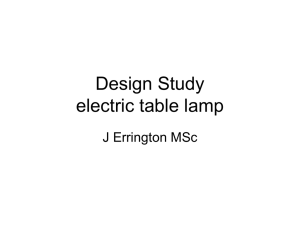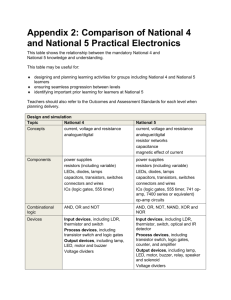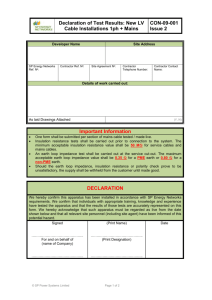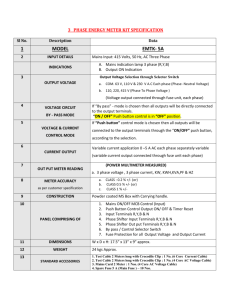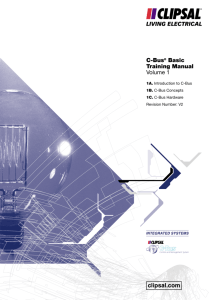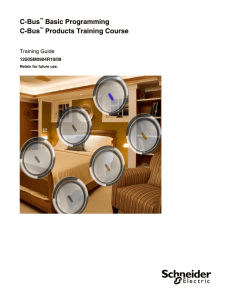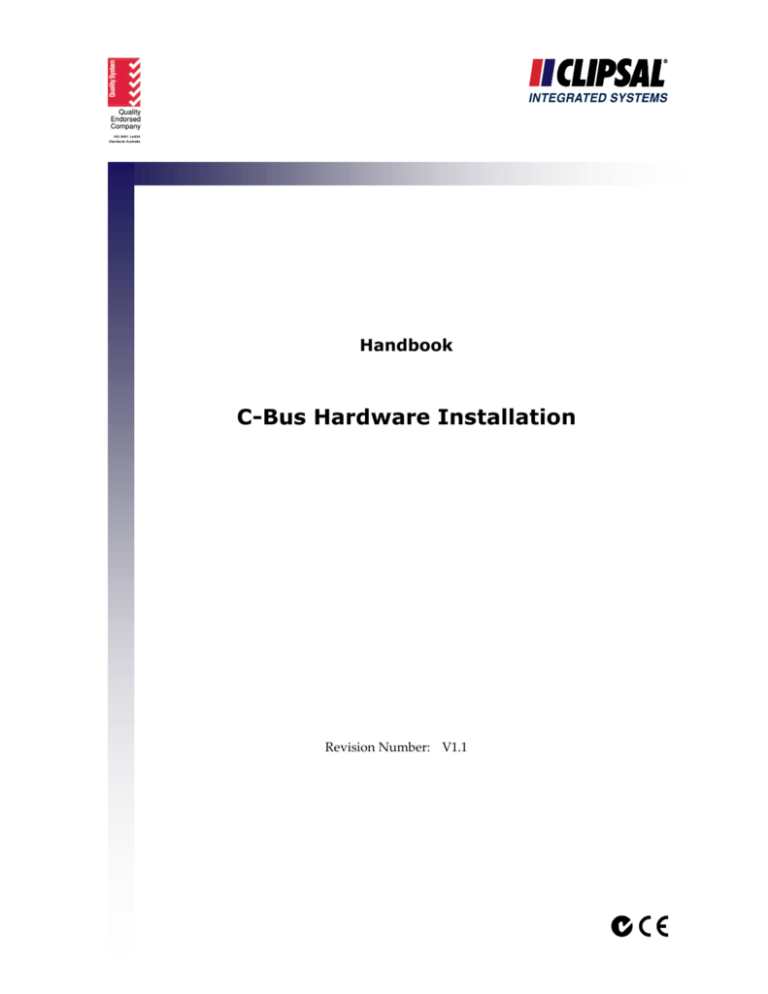
Handbook
C-Bus Hardware Installation
Revision Number: V1.1
© Copyright Clipsal Integrated Systems Pty Ltd 2006. All rights Reserved. This material is copyright
under Australian and international laws. Except as permitted under the relevant law, no part of this
work may be reproduced by any process without prior written permission of and acknowledgement to
Clipsal Integrated Systems Pty Ltd.
Clipsal and C-Bus are registered trademarks of Clipsal Australia Pty Ltd.
The information in this manual is provided in good faith. Whilst Clipsal Integrated Systems (CIS) has
endeavoured to ensure the relevance and accuracy of the information, it assumes no responsibility for
any loss incurred as a result of its use. CIS does not warrant that the information is fit for any
particular purpose, nor does it endorse its use in applications which are critical to the health or life of
any human being. CIS reserves the right to update the information at any time without notice.
V1.0 Mar 2006
Contents
Scope
Learning outcomes
1.0
2.0
3.0
4.0
5.0
6.0
7.0
8.0
C-Bus Fundamentals
1.1
C-Bus Installation Rules
Mains Voltage Supply
2.1
Mains Voltage
2.2
Inverter Supply
2.3
Uninterruptible Power Supply
Cable Segregation
3.1
Wiring Within C-Bus Enclosure
3.2
Field Wiring
Circuit Protection
4.1
Miniature Circuit Breakers
4.2
HRC Semiconductor Fuses
4.3
Protecting C-Bus Mains
4.4
Protecting C-Bus Loads
Cable Testing
5.1
Mains Cable Testing
5.2
Cable Sizes
5.3
C-Bus Cable Polarity and Pairing
5.4
Cable Jointing
Wiring Relay Loads
6.1
Voltage Connections
C-Bus Dimmers
7.1
Dimmer Phase Connections
Single Network Topology
8.1
Daisy Chain Topology
8.2
Star Topology
8.3
Closed Loop Topology
Appendix 1
4
4
5
6
7
8
8
8
9
10
12
13
14
15
16
16
17
18
18
19
20
22
23
25
26
27
28
28
29
30
C-Bus Hardware Installation
Scope
This handbook aims to provide an installer of C-Bus with the basic knowledge needed to install
C-Bus products. Appropriate licenses and a technical trade background is required.
This handbook is aimed at people who wish to install C-Bus hardware, but do not know much
about C-Bus.
Learning Outcomes
By the end of this module, you should have an understanding of the basics needed to install
C-Bus products including:
•
C-Bus fundamentals
•
mains voltage supply
•
cable segregation
•
circuit protection
•
cable testing
•
wiring relay loads
•
C-Bus dimmer
•
single network topology.
Handbook
4
C-Bus Hardware Installation
1.0
C-Bus Fundamentals
This chapter will explain the fundamental properties of C-Bus. These
properties reflect on the way that C-Bus units are installed. The
fundamentals include:
• C-Bus network topology
• C-Bus cable type
• C-Bus voltage
• C-Bus current per network
• maximum C-Bus cable length
• distance between C-Bus units
• maximum number of C-Bus units
• network impedance.
Handbook
5
C-Bus Hardware Installation
1.1
C-Bus Installation Rules
There are a number of basic rules you must follow when installing C-Bus products. These rules
are listed in Table 1.
Rule
Description
C-Bus Network Topology
C-Bus units are wired in Daisy Chain or Star
configuration. Do not wire C-Bus units in loop
configuration.
C-Bus Cable Type
All C-Bus Networks use an Unshielded Twisted Pair
(UTP), Cat-5 (cable) as the communications medium.
The Clipsal catalogue number for this product is
5005C305B.
C-Bus Voltage
The standard C-Bus voltage should be 36 V DC (this
may vary slightly). It is recommended that the voltage
be no lower than 25 V DC.
Maximum C-Bus Current per
Network
The C-Bus Cat-5 (cable) must not carry current in excess of
2 A.
Maximum Cable Length per
C-Bus Network
The maximum distance of C-Bus cable on a C-Bus network
must not exceed 1 km.
Maximum Distance Between
all Units
The maximum distance of cable between all C-Bus units,
must not exceed 1 km.
Maximum Number of Units
per Network
As a rule of thumb, the amount of units on a C-Bus
network, must not exceed 100 units. In practice, this may
be less, depending on how much current is being drawn
by the C-Bus units.
Network Impedance
The network impedance of the C-Bus network must be
between 400 Ω and 1.4 kΩ. This can be achieved by adding
or removing a network burden.
Table 1: C-Bus parameters.
Handbook
6
C-Bus Hardware Installation
2.0
Mains Voltage Supply
The mains supply to a C-Bus device is just as important as the C-Bus
supply. Unfortunately mains power cannot be controlled by an end
user, so it is important to know how mains voltage may effect a
network.
Handbook
7
C-Bus Hardware Installation
2.1
Mains Voltage
The mains voltage is simply the supply for powered C-Bus units, and various loads controlled
by C-Bus.
C-Bus units are available in two different voltage formats (identified by different part numbers).
The accepted mains voltages are:
1) 240 V AC @ 50 Hz
2) 110 V AC @ 60 Hz.
Please ensure that the C-Bus products you purchase are designed to suit the supplied
mains voltage in your country.
2.2
Inverter Supply
Many C-Bus units that use mains power, are designed to operate from a sinusoidal mains
voltage waveform. If an Inverter Supply (that produces a square wave voltage) is used, C-Bus
units may not operate as expected or may become damaged.
2.3
Uninterruptible Power Supply
An Uninterruptible Power Supply (UPS) may be used, if the output voltage and frequency are
within acceptable limits for C-Bus units (that require mains power). These limits are:
• that the UPS must operate between the voltages 190 V and 265 V
• that the UPS must maintain a frequency of 50 Hz or 60 Hz, ±3 Hz
• the frequency may only vary by 3 Hz over 1 minute.
C-Bus Dimmers are the only C-Bus units that are effected by the shift of voltage and
frequency.
Handbook
8
C-Bus Hardware Installation
3.0
Cable Segregation
When installing C-Bus units, you will find that many units have:
• mains voltage terminals
• 36 V DC C-Bus connections.
Care must be taken to adequately segregate the 240 V AC wiring
from the C-Bus wiring.
It is strongly recommended, that mains voltage cabling must be fixed
in the distribution board. Fixing mains cables can be achieved by
using cable ties or trunking as required by local cabling rules.
Care must be taken not to allow copper strands to enter DIN unit
apertures. To stop copper strands from entering RJ45 sockets, fit
rubber bungs to all unused sockets (3 rubber bungs are usually
supplied).
For additional information on wiring cable segregation, please
consult Appendix 1.
Handbook
9
C-Bus Hardware Installation
3.1
Wiring Within C-Bus Enclosures
Where more than one Cat-5 cable enters the switchboard, care must be taken to ensure that any
joins made between multiple Cat-5 cables, are effectively insulated with no exposed C-Bus
terminals.
Consider terminating multiple C-Bus Cat-5 cables outside the switchboard, and one
C-Bus cable into the Distribution board (see Figure 1).
By utilising RJ45 connectors on a C-Bus Cat-5 (cable), you can ensure that the mains voltage is
not exposed to any C-Bus connectors. This provides adequate segregation between C-Bus and
mains voltage.
approved terminal strip
N
A/L
1
2 3
4
5
6 7
8
1A 1B
2A 2B 3A 3B
4A 4B
5A 5B
6A 6B 7A 7B
8A 8B
1A 1B
2A 2B 3A 3B
4A 4B
5A 5B
6A 6B 7A 7B
8A 8B
Unit
C-Bus
C-Bus CONNECTIONS
N
A/L
1
2 3
4
5
6 7
8
Unit
C-Bus
C-Bus CONNECTIONS
Figure 1: Terminating multiple C-Bus Cat-5 cables to enter a distribution board.
Handbook
10
C-Bus Hardware Installation
Below is an example of a wired distribution board. Please take note that:
• all mains cables are fixed using cable ties
• a single C-Bus cable entering the enclosure
• all C-Bus connections made via RJ45 connectors.
Handbook
11
C-Bus Hardware Installation
Figure 2: A sample of an enclosure wiring.
Handbook
12
C-Bus Hardware Installation
3.2
Field Wiring
When wiring the C-Bus Cat-5 cable in the field (outside of the distribution board):
• that you maintain a minimum of 150 mm separation between C-Bus and mains cable,
when running C-Bus cable in parallel with mains.
• ensure that C-Bus always crosses mains cable at a 90 degree angle, with at least
60 mm of separation.
Securely anchor both Cat-5 and mains voltage cable in switchboards. This provides an
additional safety margin against contact between loose mains conductors, and the C-Bus
36 V DC wiring.
A total of less than 1000 m of C-Bus Cat-5 cable must be used per C-Bus network.
Handbook
13
C-Bus Hardware Installation
4.0
Circuit Protection
All C-Bus output units consist of electronic components that may be
damaged by surges, short circuits and overvoltages.
It is recommended that overvoltage protection should be used in the
mains switchboard. If the C-Bus Cat-5 cable is routed between
buildings or used in an outdoor installation, then protection must be
used on the C-Bus cable as well.
Handbook
14
C-Bus Hardware Installation
4.1
Miniature Circuit Breakers
Miniature Circuit Breakers (MCB’s) can be used on:
• the Input side of a C-Bus output unit
• the output side of a C-Bus output unit.
4.1.1
Input side of C-Bus output unit
To protect the mains voltage cable, an overvoltage protection device (such as the Clipsal 970
series) should be installed across each active C-Bus power supply on each C-Bus output unit (as
in Figure 3 & Figure 4).
4.1.2
Output side of C-Bus output unit
To protect the C-Bus dimmer unit and meet the safety requirements of IEC60669-2-1, a MCB
should be installed in each output channel (as in Figure 3 & Figure 4).
Dimmer Output Stage
AC Mains Supply
Neutral
Active (Line/Hot)*
Active (Line/Hot)*
Load
Neutral
Neutral
Earth
N
A/L
1 2 3 4 5
1 2 3 4
Local
toggle
buttons
C-Bus Cat-5 Cable
5005C305B
1
5 6 7 8
6 7 8 A/L N
2
1
4
5
8
7
6
3
Cat-5
Surface Box
SMRJ88A5/1
C-Bus CONNECTIONS
C-Bus Network
C-Bus Patch Cord
*Control and switching stage supplies
must be wired to the same phase
Figure 3: C-Bus 8 channel DIN Rail dimmer (L5508D1A).
Handbook
15
C-Bus Hardware Installation
Earth
Active (Line/Hot)
20 A
Neutral
Aux. Relay
Contacts
R1
R2
R2
NEUTRAL
R1
4
3
A/L
2
1
6 A*
Channel 1
WARNING
ISOLATE FROM SUPPLY BEFORE
WORKING ON THIS UNIT
6 A*
Channel 2
6 A*
Channel 3
6 A*
Channel 4
* To meet the safety requirements of
EN60669-2-1 (European Standard)
an MCB must be installed on each
output channel.
C-Bus
Remote ON
Remote OFF
Figure 4: C-Bus 4 channel professional dimmer (L5104D5).
4.2
HRC Semiconductor Fuses
HRC Semiconductor Fuses can be used instead of MCB’s to protect the mains voltage cable and
the C-Bus dimmer unit.
Handbook
16
C-Bus Hardware Installation
4.3
Protecting C-Bus Mains
Table 2 lists the MCB’s or fuses to be used on the input side of C-Bus output unit.
C-Bus Output Units
DIN Rail Series
Dimmer
Modules
Professional Series
High Power Professional
Series
Voltage Free Relay
Catalogue Number
Max load per MCB/Fuse range per
Unit
Phase
L5508D1A or
L5508D1AP
L5504D2A or
L5504D2AP
L5104D5
L5102D10
L5101D20
L5112D10B2
L5112D12B2
L5112D16B2
L5112D20B2
55xxRVF
3
3
3
3
8A
8A∗
8A
8A∗
20 A
20 A
20 A
× 40
× 48
× 64
× 80
N/A
20 A ∗
20 A ∗
20 A ∗
× 40 A
× 50 A
× 80 A
× 80 A
N/A
A
A
A
A
3
3
3
3
∗
∗
∗
∗
Table 2: Protection device fitted to the Input side of C-Bus units.
∗ The MCB/Fuse range for the input side of a C-Bus output unit, should be suitable for the incoming
supply.
4.4
Protecting C-Bus Loads
Table 3 lists the MCB’s or fuses to be used on the output side of C-Bus output unit.
C-Bus Output Units
DIN Rail Series
Dimmer
Modules
Professional Series
High Power Professional
Series
Voltage Free Relay
Catalogue Number
L5508D1A or
L5508D1AP
L5504D2A or
L5504D2AP
L5104D5
L5102D10
L5101D20
L5112D10B2
L5112D12B2
L5112D16B2
L5112D20B2
55xxRVF
Max load per
Channel
MCB/Fuse per
Channel
1A
1A∗
2A
2A∗
5A
10 A
20 A
10 A
12 A
16 A
20 A
10 A
6A∗
10 A ∗
20 A ∗
10 A ∗
12 A ∗
16 A ∗
20 A ∗
N/A
Table 3: Protection device fitted to the output side of C-Bus units.
∗ The MCB/fuse range for the output side of C-Bus output unit should be suitable for protecting each
individual output channel.
Handbook
17
C-Bus Hardware Installation
5.0
Cable Testing
For reliable operation of C-Bus, is it recommended that both the
mains cables and C-Bus cables are checked. This will ensure that
cabling conforms to standard C-Bus installation practices.
This chapter will look at:
• mains cable testing
• cable sizes
• C-Bus cable polarity and pairing
• cable jointing.
Handbook
18
C-Bus Hardware Installation
5.1
Mains Cable Testing
Megger testing the insulation of the mains voltage cable, should be carried out before connecting
any C-Bus products.
Clipsal Integrated Systems (CIS) recommends that C-Bus products be disconnected from the
mains cabling before megger testing. This will ensure a correct reading.
5.2
Cable Sizes
The table below lists the mains voltage and load cable sizes:
C-Bus Output Units
DIN Rail Series
Dimmer
Professional Series
Modules
High Power Processional
Series
Voltage Free Relay
Supply Cables (A & N) Load Cables (A & N)
2.5 mm2 or 2x1.5 mm2
1.5 mm2
4.0 mm2 or 2x2.5 mm2 4.0 mm2 or 2x2.5 mm2
6.0 mm2
4.0 mm2 or 2x2.5 mm2
2.5 mm2 or 2x1.5 mm2
Table 4: Cable sizes.
Handbook
19
C-Bus Hardware Installation
5.3
C-Bus Cable Polarity and Pairing
The C-Bus network uses Unshielded Twisted Pair (UTP), Category 5 data cable. Clipsal
manufacture a cable for C-Bus use exclusively (Cat. No. 5005C305B). This has a pink insulation,
so that there is no confusion between blue data cable and pink C-Bus Cat-5 cable (the Cat-5 cable
also tested for insulation resistance).
The following conductors of the Cat-5 cable must be used to make the C-Bus connections:
• orange + blue
C-Bus +
• orange & white + blue & white
C-Bus –
blue
orange
Correct wiring with the twist being
maintained between the two positive
conductors and their respective negative
conductors.
Figure 5: Correct pairing of C-Bus conductors.
orange
blue
Incorrect wiring. This will cause the C-Bus
network to be more susceptible to electrical
interference (if wiring is consistent).
Otherwise the bus will be short circuit.
Figure 6: Incorrect pairing of C-Bus conductors.
The use of Cat-5 UTP minimizes the coupling of external magnetic fields onto the cable, thus
reducing interference on the C-Bus cable.
The two wires for each of the positive and negative rails of the C-Bus cable decreases the wire’s
resistance. Putting a wire in parallel with another wire of the same resistance, you will
effectively halve the resistance. This then decreases the potential voltage drop that may be lost
over long lengths of cable.
The mains side of C-Bus is wired in accordance the relevant standards that apply in your region.
C-Bus cable is run and connected with similar rules that govern data cabling.
Handbook
20
C-Bus Hardware Installation
5.4
Cable Jointing
Cat-5 (cable) is most commonly single strand 0.2sq mm copper in each conductor. The following
are the recommended termination and jointing techniques for installing a C-Bus network.
Care must be taken when twisting the conductors together, so the wires don’t break (Figure 7).
Care must also be taken to ensure all core wires are secure.
Conductors Twisted Together
• Maximum 2 conductors.
• Over twisting may cause wire
to break.
Figure 7: Conductors twisted together.
By using a small bootlace or ferrule crimps, the Cat-5 conductors can be securely held (Figure 8).
Depending on the size of the crimp used, more than one crimp may be held in a terminal.
Conductors Crimped Together
• Maximum 4 conductors.
Figure 8: Conductors crimped together.
Soldering the conductors together shrinks back the insulation, making short circuits between
conductors more likely (Figure 9). Over time solder will cold flow away from the point of
pressure causing an intermittent or high resistant joint.
Conductors Soldered Together
• Not recommended.
• Joint will become loose over
time.
Figure 9: Conductors soldered together.
Handbook
21
C-Bus Hardware Installation
A RJ45 plug is also another approved way of terminating C-Bus to C-Bus output units.
The pin-out for the RJ45 is as shown below in Table.
Pin
Connection
Colour
1
Remote Override ON
Green/White
2
Remote Override ON
Green
3
C-Bus Negative (-)
Orange/White
4
C-Bus Positive (+)
Blue
5
C-Bus Negative (-)
Blue/White
6
C-Bus Positive (+)
Orange
7
Remote Override OFF
Brown/White
8
Remote Override OFF
Brown
Clip Facing Down
12345678
Table 5: Pin Out for an RJ45 C-Bus termination.
Handbook
22
C-Bus Hardware Installation
6.0
Wiring Relay Loads
It is important not mix different output voltages on the channels of a
C-Bus Relay (SELV and LV).
The voltage classifications are:
• Safety Extra Low Voltage (SELV): (< 50 V AC or <1 20 V DC)
• Low Voltage (LV): (50 – 1000 V AC or 120 – 1500 V DC)
• High Voltage (HV): (1000V AC or 1500 V DC)
The ranges above are a reference, please refer to your local
authority standards.
Handbook
23
C-Bus Hardware Installation
6.1
Voltage Connections
When wiring loads to C-Bus relays it is stongly recommended, that each channel on the unit fall
into only one of the following classifications:
• Safety Extra Low Voltage (SELV)
• Low Voltage (LV)
• High Voltage (HV)
Figure 10 shows 24 V DC (which is SELV) and 240 V AC (which is LV) being connected to the
same dimmer.
This is not the correct wiring for this application. It is recommended to use a separate
relay unit for each voltage classification you want switched.
SELV
(e.g. 24 V DC)
Active (Line/Hot)
LV
(e.g. 240 V AC)
Neutral
Load
Earth
N
A/L
1
2 3 4
5
Load
1A 1B
2A 2B
3A 3B 4A 4B
5A 5B
6A 6B
7A 7B
8A 8B
9A 9B 10A10B 11A 11B 12A12B
6
Unit
7 8
9 10 11 12
C-Bus
C-Bus CONNECTIONS
Figure 10: Incorrect mixed voltage classification.
Handbook
24
C-Bus Hardware Installation
The correct wiring for a C-Bus relay is shown in Figure 11 and Figure 12.
Figure 11 shows 2 different voltages being switched by two relays. Although they are both
different voltages, they both fall into the SELV classification.
SELV
(e.g. 48 V DC)
Active (Line/Hot)
SELV
(e.g. 35 V AC)
Neutral
Load
Earth
N
A/L
1
2 3 4
5
Load
1A 1B
2A 2B
3A 3B 4A 4B
5A 5B
6A 6B
7A 7B
8A 8B
9A 9B 10A10B 11A 11B 12A12B
6
Unit
7 8
9 10 11 12
C-Bus
C-Bus CONNECTIONS
Figure 11: Correct voltages mixed.
Figure 12 shows 2 different voltages being switched by two relays. Although they are both
different voltages, they both fall into the LV classification.
LV
(e.g. 110 V AC)
Active (Line/Hot)
LV
(e.g. 240 V AC)
Neutral
Load
Earth
N
A/L
1
2 3 4
5
Load
1A 1B
2A 2B
3A 3B 4A 4B
5A 5B
6A 6B
7A 7B
8A 8B
9A 9B 10A10B 11A 11B 12A12B
6
Unit
7 8
9 10 11 12
C-Bus
C-Bus CONNECTIONS
Figure 12: Correct voltages mixed.
Handbook
25
C-Bus Hardware Installation
7.0
C-Bus Dimmers
C-Bus wired dimmers are leading edge phase control dimmer for
incandescent & low-voltage lighting application (iron core and
electronic transformer). Electronic Transformers must be suitable for
leading edge technology.
Handbook
26
C-Bus Hardware Installation
7.1
Dimmer Phase Connections
Mains voltage supply to the Control and Switching Stages of the C-Bus DIN Rail dimmers are
not internally connected.
Both must be wired from the same voltage phase. Do not cross the neutral connections.
Figure 13 shows the correct way to wire a C-Bus DIN Rail dimmer, with the same phase being
looped between the voltage supply and the switching supply.
Active (Line/Hot)
Neutral
Earth
Load
Red, White or
Blue Phase
1
N
A/L
1 2 3 4 5
1 2
3 4
5 6
7 8
6 7 8 A/L N
C-Bus CONNECTIONS
Figure 13: Correct wiring, with the same phase.
Figure 14 shows the incorrect way to wire a C-Bus DIN Rail dimmer, with the different phases
being used on the voltage supply and the switching supply.
Active (Line/Hot)
Active (Line/Hot)
Neutral
Neutral
Earth
Load
White Phase
Red Phase
1
N
A/L
1 2 3 4 5
1
2 3
4
5
6 7
8
6 7 8 A/L N
C-Bus CONNECTIONS
Figure 14: Incorrect wiring, due to different phases.
Handbook
27
C-Bus Hardware Installation
8.0
Single Network Topology
All C-Bus units may be wired in daisy chain, star or a combination of
both configurations, ultimately all conductor connections are
parallel. When Clipsal uses the term location daisy chain or star, it
simply refers to the physical positions of units & the way cables are
physically run. A closed ring configuration must not be used.
Handbook
28
C-Bus Hardware Installation
8.1
Daisy Chain Topology
The daisy chain wiring configuration (shown in Figure 15), is basically a run of units, connected
with its positive and negative terminals in parallel.
Figure 15: Correct daisy chain topology.
8.2
Star Topology
Figure 16 shows some input units wired in a star configuration. This is basically a run of units,
connected with multiple wires coming into the positive and negative terminals in parallel.
If two or more cable runs branch off from a single point, it is referred to as a star configuration.
Figure 16: Correct star topology.
Handbook
29
C-Bus Hardware Installation
8.3
Closed Loop Topology
A loop configuration must not be used. Wiring the C-Bus network in this configuration is not
necessary and will cause the C-Bus network to act unexpectedly.
Figure 17: Incorrect closed loop topology.
Handbook
30
C-Bus Hardware Installation
Appendix 1
MAINTAINING SEPARATION BETWEEN 240 V MAINS WIRING AND
C-BUS Cat-5 UTP CABLE
The C-Bus DIN range of products has proved to be very popular. They offer cost effective
performance. Their small ‘footprint’ and DIN clip mounting was designed to allow them to be
mounted into switchboards and consumer units.
With all C-Bus units that have mains as well as 36 V DC bus connections care must be taken to
adequately separate the 240 V AC wiring from the bus wiring. Within the confines of a
switchboard this will require the use of the C-Bus pink Cat-5 UTP which has mains rated
insulation in its outer sheath.
Wiring practices vary from installer to installer, some times the mains cable entering the
switchboard is double insulated sometimes it is single insulated. Even where it is double
insulated, the outer insulation must be stripped back to allow the connections of the mains wires
to the DIN units power supply and output terminals.
Where the Pink C-Bus Cat-5 cable enters the switchboard, if it then plugs straight in to a DIN
module no problems with isolation between it and any single insulated mains cable can be
expected. The 300 mm pink Cat-5 patch leads supplied with all DIN units should then be used
to loop in and out of any other DIN units in the enclosure.
Where more than one pink Cat-5 cable enters the switchboard care must be taken to ensure that
any join made between multiple Cat-5 cables is effectively insulated with no exposed terminal
screws etc.
It may be worth considering terminating multiple C-Bus Cat-5 cables outside the switchboard so
that you can bring just one pink Cat-5 straight in to the RJ socket on one of the DIN units.
The Mains rated pink insulation will allow the C-Bus Cat-5 cable to be run closer to mains
wiring than would be allowed under normal circumstances. It is still good practice to keep them
as far apart as possible and cross at 90 degrees to give the greatest margin of noise immunity
both within the confines of the switchboard and around the installation.
Most importantly, securely anchoring both pink Cat-5 and mains cables in switchboards
will give additional safety margin against inadvertent contact between loose mains
conductors and the C-Bus 36 V DC wiring.
All of these issues are covered by the wiring regulations, there is an obligation for an
installer to ensure that wiring is not carried out in a dangerous manner. While the
safety and protection of equipment users is of the highest importance the product
warranty will also be effected should a failure be found to be caused by poor wiring
practice. In addition the isolation between mains and C-Bus wiring is one of the key
checks made during a CIS Approved Installer site visit.
Handbook
31

